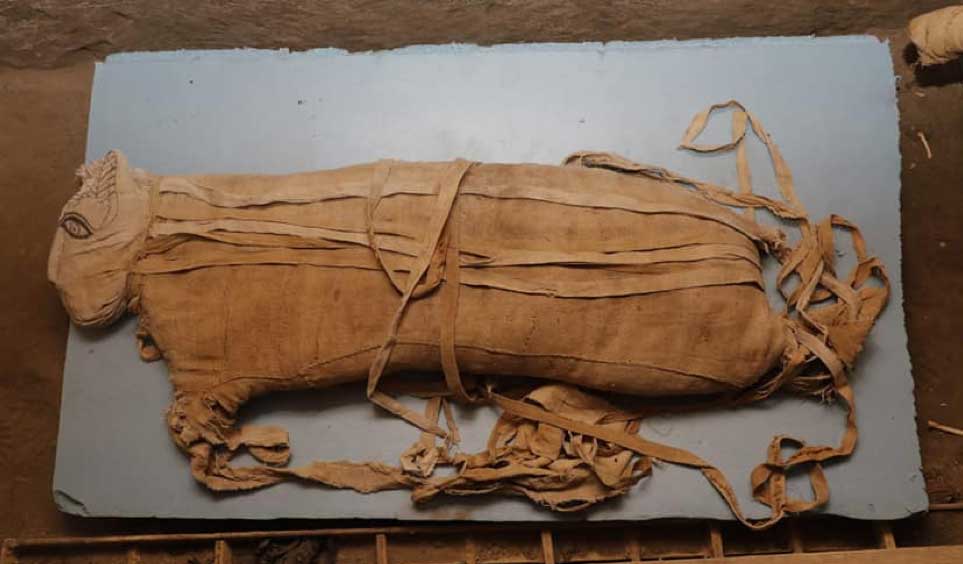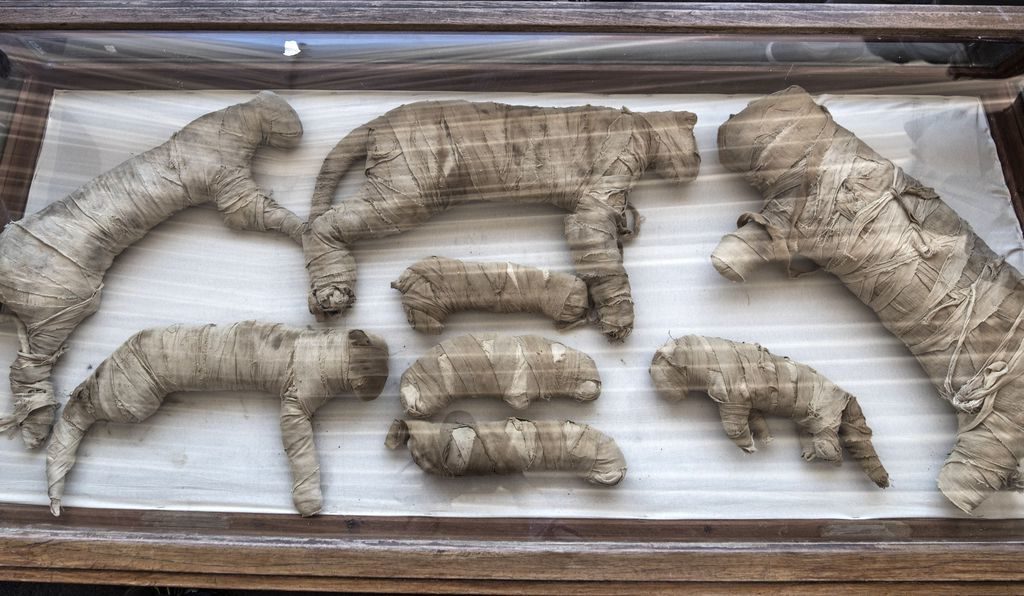Archaeologists Reveal Rare Mummified Lion Cubs Unearthed in Egypt

Archaeologists Reveal Rare Mummified Lion Cubs Unearthed in Egypt
The authorities in Egypt have announced that the necropolis of Saqqara was a rare discovery of mummified lion cubs, big cats, cobras and Crocodiles that date from around 2,600 years ago.

The collection for ancient mummified animals contains dozens of mummified cats and birds; An enormous mummified beetle reported being “three to four times” the normal size and 75 wooden and bronze cat statues.
The big mummified cats were found near the remains of an adult mummified lion discovered under the necropolis of Saqqara in 2004 and while two were identified as lion cubs, three more need further analysis to determine their species
A Guardian report quotes an excited Mostafa Waziry, the head of the Supreme Council of Antiquities in Egypt, saying that if these three animals are known as cheetahs, leopards, lioness or panthers, they will be “one of their kind” in ancient Egypt.

Dr. Salima Ikram is an Egyptologist and mummy researcher at Cairo’s American University and said the animal mummies dated back to the Ptolemaic period that ended in 30 BC. At that time, worshippers in ancient Egypt either kept mummified animals as real deities or mummified creatures in order to offer them to their gods
This, according to Dr Ikram would have more potency as it was a “blood sacrifice” compared to the perceived magical energies associated with stone or wooden images.
In 2019 April BBC news an report about a similar discovery when archaeologists uncovered dozens of mummified cats and mice among a stash of around 50 animals laid to rest in an ancient tomb about 390km (242 miles) south of Cairo near the Egyptian town of Sohag.
This tomb was built for a man named ‘Tutu’ and his wife who lived in the early Ptolemaic period, which ended with the Roman conquest in 30 BC and like the new discoveries greatly added to Egyptologist’s understanding of animal worship and mummification rites.


The tomb in Sohag contained a range of mummified animals and birds including more than 50 mummified mice and cats and even a mummified falcon which informed all creatures great and small were scarified and worshipped. Following the ritual path and evolution of the cat goddess, according to G. D.
Hornblower’s 1943 book The Divine Cat and the Snake in Egypt “ Mafdet’ was the first cat-headed deity worshipped during the First Dynasty (2920–2770 BC). Regarded as protector of the Pharaoh’s chambers against snakes, scorpions and all things evil, Mafdet was often also depicted with a head of a leopard.
The later cat deity Bastet was worshipped from at least the Second Dynasty (2890 BC) onwards and was depicted with a lion’s ( Panthera leo’s ) head and a wall painting in the Fifth Dynasty’s burial ground at Saqqara shows a small cat with a collar suggesting to archaeologists that African wildcats were tamed kept in the pharaonic quarters by the 26th century BC. And reflecting real-world occurrences, as time unfolded in ancient Egypt, the once wild cat goddess herself became tamer and was worshipped as ‘Bast’.

Egyptian officials hope that their recent announcement will help to boost the country’s image abroad and ultimately that these ancient mummified lion cubs and cats will encourage tourists to continue visiting Egypt as the country aims to bring back its 14 million visitors a year who came to the country in 2010, before the 2011 revolution which overthrew former autocrat Hosni Mubarak.
An almost final nail in the coffin of Egypt’s flagging tourist industry occurred after Metrojet flight 7K9268 was brought down close to the resort town of Sharm el-Sheikh in 2015, but things are turning around, fast.
According to a report in Alborsaanews, last year Egypt saw a surge in arrivals with 11.3 million people visiting Egypt and this was in part inspired and caused by the UK lifting its ban on flights to Sharm el-Sheikh that had been in place since 2015.
“It’s a wonderful promotion for Egypt,” says Khaled El-Enany, Egypt’s antiquities minister, who told The Guardian that believes these new mummies will spark curiosity among potential visitors to the country in the run-up to the opening of the Grand Egyptian Museum close to the Saqqara necropolis.